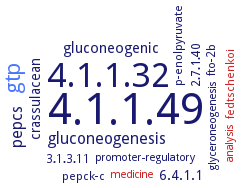Please wait a moment until all data is loaded. This message will disappear when all data is loaded.
Please wait a moment until the data is sorted. This message will disappear when the data is sorted.
D263E
-
16800fold reduction in maximal velocity compared to wild-type enzyme, KM-value for ADP is 1.8fold lower than wild-type value, KM-value for phosphoenolpyruvate is 1.3fold higher than wild-type value, KM-value for HCO3- is 1.1fold lower than wild-type value
H225E
-
600fold reduction in maximal velocity compared to wild-type enzyme, KM-value for ADP is 2.4fold lower than wild-type value, KM-value for phosphoenolpyruvate is 2.6fold lower than wild-type value, KM-value for HCO3- is 1.1fold higher than wild-type value
D269E
-
site-specific mutagenesis
deltaF409
-
site-specific mutagenesis, deletion of Phe409
E508Q/E511Q
-
site-specific mutagenesis
F409A
-
site-specific mutagenesis
F413A
-
site-specific mutagenesis
R2S
-
site-specific mutagenesis
R396S
-
site-specific mutagenesis
R396TAA
-
site-specific mutagenesis, termination codon at position 396
D241A
complete loss of activity
D242A
complete loss of activity
H205Q
mutation remarkably diminishes the activity, Km value for Mn2+ is 250fold increased
Y180A
10fold in crease in Km value of Mn2+
Y180F
2- and 8fold decrease in specific acitvity for the oxaloacetate- and phosphoenolpyruvate-forming reactions, respectively
E272Q
-
the mutation increases the activation constant for Mn2+ in the main reaction of the enzyme 11fold
E284Q
-
the mutation increases the activation constant for Mn2+ in the main reaction of the enzyme 69fold, the mutation changes the nucleotide-independent oxalacetate decarboxylase activity of PEP carboxykinase into an ADP-requiring activity
E299A
-
the mutation has no effect on catalytic efficiency
H233Q
-
mutation leads to less polar environment for the phosphoryridoxyl group, decreased binding affinity of phosphoenolpyruvate
K212M
-
the mutation increases the activation constant for Mn2+ in the main reaction of the enzyme 17fold, the mutation changes the nucleotide-independent oxalacetate decarboxylase activity of PEP carboxykinase into an ADP-requiring activity
K212R
-
the mutation does not affect the Mn2+ affinity of the enzyme
K213Q
-
the mutation increases the activation constant for Mn2+ in the main reaction of the enzyme 107fold, the mutation changes the nucleotide-independent oxalacetate decarboxylase activity of PEP carboxykinase into an ADP-requiring activity
K214R
-
mutation leads to less polar environment for the phosphoryridoxyl group, decreased binding affinity of phosphoenolpyruvate
L460A
-
the mutation decreases the catalytic efficiency to about 14% of the wild type value as a consequence of the 7fold increase in the Km (ATP-Mn2-). The mutation decreases the catalytic efficiency to about 7% of the wild type value as a consequence of the 3fold increase in Km (ADP-Mn-) and the reduction in kcat
R457M
site directed mutagenesis
R70K
-
1.7fold increase in KM-value for ADP, 1.3fold increase in KM-value for phosphoenolpyruvate, 1.4fold increase in KM-value for HCO3-
R70M
-
2.5fold increase in KM-value for ADP, 2.4fold increase in KM-value for phosphoenolpyruvate, 1.8fold decrease in KM-value for HCO3-
R70Q
-
1.9fold increase in KM-value for ADP, 2.3fold increase in KM-value for phosphoenolpyruvate, 1.1fold increase in KM-value for HCO3-
S252A
side directed mutagenesis
additional information
-
metabolic control of liver gluconeogenesis is quantified in groups of knock-out mice with varying PEPCK protein content. Livers with a 90% reduction in PEPCK content show only a 40% reduction in gluconeogenic flux, indicating a lower than expected capacity for PEPCK protein content to control gluconeogenesis. PEPCK flux correlates tightly with TCA cycle activity, suggesting that under some conditions in mice, PEPCK expression must coordinate with hepatic energy metabolism to control gluconeogenesis
F216Y

-
kinetic parameter in the PEP carboxylation direction: Km: 0.170 mM (MnADP-), 0.917 mM (phosphoenolpyruvate), 0.056 mM (Mn2+), 0.024 mM (HCO3-)
F216Y
-
kinetic parameter in the PEP formation direction: Km: 0.016 mM (MnATP2-), 1.079 mM (oxalacetate), 0.345 mM (Mn2+)
F216Y
-
Km: 0.075 (MnADP-), 0.323 (phosphoenolpyruvate), 17 (HCO3-), 0.063 (Mn2+). Mutation Phe216Tyr shows that the introduction of a hydroxyl group in the lateral chain of the residue produces a substantial loss in the enzyme affinity for Mn2+, suggesting an increase of the pKa of Lys213
F216Y
-
mutation Phe216Tyr shows that the introduction of a hydroxyl group in the lateral chain of the residue produces a substantial loss in the enzyme affinity for Mn2+, suggesting an increase of the pKa of Lys213
F216Y
-
pH: 6.5: Km: 0.073 mM (Mn2+), pH: 8.1: Km: 0.035 mM



 results (
results ( results (
results ( top
top






